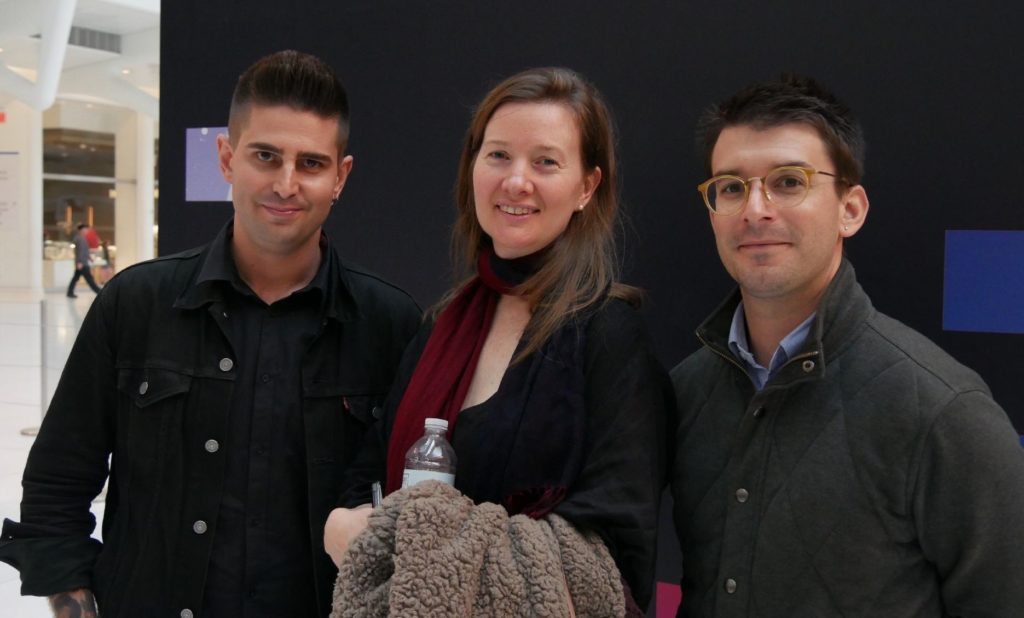The Tribeca Virtual Reality Arcade opened at the Westfield World Trade Center in New York City on November 4, giving visitors free access to four different immersive experiences. The arcade will be showing for one last time this weekend from November 18-20, giving shoppers and tourists a chance to try out VR, perhaps for the first time, using Samsung Gear VR viewers.
One of the stand-out experiences is an episodic VR series called Invisible, a supernatural drama created by director Doug Liman (The Bourne Identity, Edge of Tomorrow), Oscar-nominated screenwriter Melisa Wallack (Dallas Buyers Club), and Emmy-nominated Julina Tatlock at the 30 Ninjas film studio. Invisible is also produced in partnership with Jaunt VR, Samsung VR, and Condé Nast Entertainment and is presented by Lexus.
Both Doug Liman and executive producer and director for Invisible, Julina Tatlock, spoke on a panel about creating VR content. One challenge was a list of “rules” for VR, which Liman, Tatlock and others at 30 Ninjas decided to cast aside. As a result, Invisible has a look that is distinct from other VR experiences, with different camera cuts and out-of-body camera positioning.
During the panel, Liman explained that after working to bring audiences close-up into the action in his movies, “The first time I put on VR equipment, I thought ‘this is even more immersive than anything I’ve been able to accomplish.’” That experience helped inspire the director to bring the action from his 2D films into the VR world.
Julina Tatlock also discussed the technical challenges, adding that “the fact that things were hard just made us want to crack it more.”
Tatlock and Lewis Smithingham, director of photography and editor for the show, spoke to [a]listdaily from the Tribeca VR Arcade premiere. They are joined by Jaunt VR executive producer, Tom Vance, and the three discuss how virtual reality technology is impacting filmmaking and how it could influence the future of moviegoing entertainment.

How did the idea to create Invisible come together?
[Tatlock]: Doug [Liman] and I started 30 Ninjas about seven or eight years ago, and we were talking about creating Invisible in some form—TV, movie or graphic novel. At the same time, I was looking into VR and started to get excited about it. So, the creative development and creative interest in VR came together, and it was about in the early spring of 2015 that we had a script and started talking to partners. I was talking to Samsung, Jaunt and Condé Nast separately as a VR project when it occurred to everybody that all three were interested, and maybe the project would be better if everybody pooled both their financial and creative resources.
What made you decide on an episodic format instead of a single film?
[Tatlock]: The expectation, when we wrote this in 2015, was that people would not want to wear a headset for very long, so you needed to build in Acts because people wouldn’t be comfortable or they would have a short attention span. What we found, as we were making it through the year, was that we wanted fewer and fewer Act breaks. It was initially conceived of as a six-episode series, and we broke it down into five episodes. I think we’ll be discussing, when we do the next thing, that longer is probably better. It gives you more runway for the story and time to invest in the characters and experience.
[Vance]: For us, releasing all the episodes at once—allowing for a bingeable experience—gives the viewer the option of sitting and watching the show in one fell swoop or watching episode-by-episode. We were certainly interested in seeing how the user experienced the episodes, and when we made the determination to release them all at one time, we all felt that if one single person sat through the entire show that we did our jobs really well. What’s great is that, more often than not, people are sitting through the entire experience.
From your experience working on Invisible, how far are we from having a full-length VR film?
[Smithingham]: We could do it. It’s just a matter of funds.
[Vance]: Not far away at all. There are feature-length projects happening around town and at Jaunt. So, it’s around the corner.
How is Invisible being distributed?
[Tatlock]: You can find Invisible on Samsung VR as well as through the Jaunt VR player.
[Vance]: In our partnership with Samsung and CNE (Condé Nast Entertainment), Samsung was an exclusive distribution partner. It is now being widely distributed both on the Samsung VR store and the Jaunt VR app.
On the panel, you spoke about following or breaking the rules of VR content creation. Do you feel that you’re writing the rules as you go?
[Tatlock]: We did think we were making it up. I like to say making up, Doug likes to say, “break the rules and create new ones.” We looked creatively at what the right thing to do was. Sometimes we did shots that were covered a couple of ways because we weren’t quite sure how well they would work. But we went in knowing a couple of different things:
- We knew that we were cutting; you’re not a person—you’re inside a story, but sometimes you’re on the floor and sometimes you’re hanging off a building. We’re not really concerned with what you, the audience member, thinks of where your feet are.
- We weren’t writing to any kind of audience role, because as an action-thriller, we wanted to tell a compulsive story and we were not stopping.
- We knew that we were going to be moving the camera. We didn’t quite know how much, but we certainly knew we were going to.
But there were rules that we weren’t going to break. [For example] we pretty much knew that we were always going to be stabilizing the camera. But even some of the rules we thought we were never going to break, we ended up breaking.
[Smithingham]: What’s truly amazing was that essentially, we had shots that were safety shots and then we had shots we were calling experimental. They were experimental because we had never tried them before. Almost every single one of those shots made it into the show.
[Tatlock]: Every day we had a first on set. You could not go through a day without asking, “Will that work? I don’t know, let’s try it.”
[Smithingham]: The idea of us making up rules feels so final. The one rule we did have was: “Don’t make it boring. Ever.” I think we followed that.
With different location-based VR experiences, particularly how IMAX plans to create VR movie theaters, how do you think the technology will impact Hollywood filmmaking?
[Vance]: What I think you’ll end up seeing is that there will be a VR theater within a larger Cineplex, and that will be a draw that will eventize the filmgoing experience. Already, you’re seeing VR being used to market and promote feature films. There are things happening within the film industry today where VR is part of the theatrical experience. I absolutely believe that VR is going to change the world and I think it’s going to affect every aspect of the moviegoing experience, but I don’t mean to suggest that VR will replace film. I see it as something that is totally distinct.
Has any consideration been given to adding more interactivity to experiences like Invisible?
[Smithingham]: Absolutely. This piece doesn’t have interactive, but I think there’s couch VR and not-couch VR. We’re developing a project right now that has some heavy-duty interactivity in it. But Invisible is interactive in the sense that you can pick where you’re going. There is a path, but you can sort of choose to not follow it, adding a level of interactivity. I think there is thought to developing interactive storytelling, and a lot of it has to do with technological constraints, such as the lack of a universal control set, which is hampering experiences right now. But as things get better and VR evolves and becomes more universal, interactivity will progress further.
I also think there’s always going to be a place for passive viewing.

